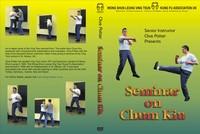Review of Clive Potter's Seminar on Chum Kiu DVD
Customer/3rd Party Review: This review was done by a customer/3rd party and is listed here for you reference only. The views and opinions of the reviewer are not those of Everything Wing Chun and do not necessarily reflect EWC's views or opinions on the subject matter. It is posted, like all customer reviews, to give you more info on the product and to give you different opinions on a product so that you can make the best decision for yourself about its content. The review is NOT by an EWC employee or contractor and EWC cannot stand by anything said in any customer/3rd party review. Enjoy!
Reviewer: George Hernandez
Date: May 04, 2011
DVD Bought on: Everything Wing Chun and is also availabe for download on Everything Wing Chun Instant Access
Technical Specifications:
Title: Senior Instructor Clive Potter Presents - Seminar on Chum Kiu
DVD Length: 1 hour 32 mins
Region: 0
Type: DVD-R
Format: NTSC
Video Quality: Average
Audio Quality: 3.0 out of 5.0
What It's About:
Seminar presented by Clive Potter, on the essential training aspects of Wing Chun’s second form Chum Kiu.
Comments:
If you purchased the first volume of the Clive Potter Wing Chun DVD on Siu Lin Tao, you can pretty much expect the same style of presentation…complete with blackboard diagrams. In his introductory comments he said that Siu LinTao is primarily for training your stance…I disagree, but everyone is entitled to their own opinion. Although he is correct about Chum Kiu’s primary purpose; that is it allows one to learn how to bridge the gap. The gap of course is that distance between you and your opponent…this is particularly obvious when your opponent moves and changes position, one naturally needs to move in a way to close the gap, if one desires to use a technique.
Sifu Potter, points out that there are three stages to Chum Ku, the first is to teach you how to turn in relationship to a moving target, the second, is how to move in a forward direction and third is how to deal with forces from different directions. He gives practical advice about the elbows and the hips and how it relates to application. One of the key points in makes in his presentation is that in Chum Kiu rotation, one does not turn on the balls of their feet…this will actually make one extremely unstable and the ability to project one’s power is lost. Each aspect of these three developmental stages are discussed and demonstrated in this one hour or so seminar.
This is an excellent DVD if you want to learn the essential aspects of making the Chum Kiu form a viable tool of Wing Chun Kung-fu. However, as with his seminar DVD on Siu Lin Tao, don’t expect him to give a full demonstration of the second form…why he doesn’t show us a full demonstration of the form as most over teachers do in their seminar DVDs, I don’t know. Perhaps, he may consider it a waste of time, since you should know the form already before you can really understand how to apply its associated applications.
Content Overview:
- Introduction
- The purpose of the Chum Kiu form
- Its three stages of development
- Relationship to a moving target.
- Moving in a forward direction.
- dealing with forces from different directions.
- Its three stages of development
- The purpose of the Chum Kiu form
- Moving in Chum Kiu
- Keeping the Centerline
- position of the elbows as it relates to the hips.
- Turning with your feet properly
- the form isn’t done with strength.
- Following a moving target.
- The critical angles.
- the position of the feet, elbows and hands
- What to do when there’s pressure on your arm.
- Turning and the other person’s centerline.
- Remember the connection of the elbow.
- Forces from different directions.
- Moving to the side and using the Bong Sao.
- Using the elbow in Chum Kiu
- Rotation and using the Wu Sao Hand
- The push kick and the double Bong Sao.
- Kicking and moving forward.
- Using the double palm strike.
- Turning and Kicking.
- Kicking toward the Centerline
- The kick as an opportunity to use your hands.
- Moving an opponent’s kick to the side.
- the position of the elbow and it’s rotation.
other blogs by user


